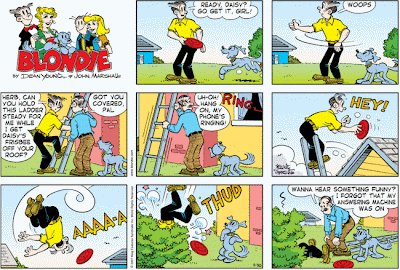Thursday, June 21st: We arrived in London on a beautiful sunny morning. This may be the first time that anyone has ever written that last sentence. After taking care of all of our travel related business, we hit the ATM to pick up some local currency. The notes are similar to Euros in that each denomination is a different size. I can understand how this might come in handy for blind people, but it's a mess for people like me who carry bills around in a money clip. If I ever relocate to Europe, I may have to invest in a new tri-fold wallet. Our withdrawal came out in a mixture of £10 and £20 notes. I was not surprised to see Queen Elizabeth II's face on the notes, but I was surprised to see another face on the back. The new £20 note features
Adam Smith on the backside while £10 note depicts
Charles Darwin. Think about that for a second. The guy on the back of England's £10 note is someone many Americans would rank somewhere between Satan and Hillary Clinton on a scale of pure evil. It's a small but poignant example of the little differences between the US and England.
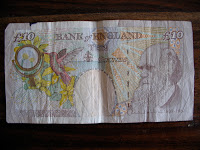
|

|
I could do without a picture of the Queen on every government issued document, but I'm definitely a fan of decorating currency with the likenesses of great intellectuals. I don't know think that's going to happen anytime soon over here, but all in all, we could have done a lot worse. Ben Franklin adorning the $100 bill, which is arguably the most useful piece of money on the planet, is remarkably subversive, at least by American standards. Another thing that we won't be seeing over here anytime soon is a legitimate $1 or $2 coin. I've always viewed our failure to embrace a coin denomination worth more than $0.25 as an example of the dark side of American exceptionalism. On this trip, however, it dawned on me that high value coins are more useful on vacation than in day-to-day life. I find that I make small purchases and interact with vending machines more often when I'm on a trip than I do when I'm at home. These are the types of transactions where high value coins excel. Of course, once we switch to an entirely electronic currency system, this entire discussion becomes moot.
From the airport, we hopped on the
Heathrow Express train and headed into London. Alan was waiting for us at home so he could give us the keys to his flat before heading off to work, so we went for the quickest ride into town. Fifteen minutes later, we pulled into Paddington Station. One of my favorite things about visiting a somewhere for the first time is the ride from the airport to wherever I'm going. It's a time to get a first impression of the city, state, or country you are visiting and start picking up on the similarities and differences between your destination and other places. It's a chance to turn a generally mundane or tiresome event like a train or taxi ride into an adventure. The strangest thing about the ride into London was how the view never really changed. The view alternated between industrial sites, farmland, and dingy apartment blocks the entire ride. The view become more residential the closer we got to Paddington, but it never felt like we were entering a great metropolis. The train ride was a preview one of the more surprising thing I learned on this trip, namely, that London doesn't really feel like a huge international city. Or, more precisely, it didn't fit my preconceived notion of how all big, international cities look and feel.
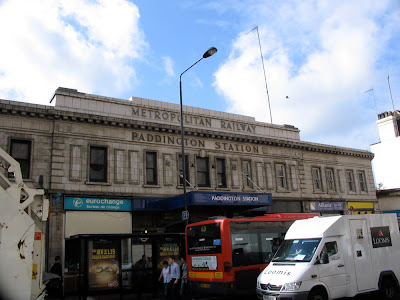
Alan's flat is only a 10 or 15 minute walk from Paddington station, and we managed to find it without too much trouble. I was a bit surprised to see how pedestrian unfriendly London is. After thinking about this some more, I realized that I was actually disappointed by how hostile it is to jaywalkers. We encountered numerous fences set up around sidewalks at intersections that forced pedestrians to use the crosswalks. As a lifelong jaywalker, this cramped my style, but it probably was better that way since it prevented me from walking into oncoming traffic after looking the wrong way. I did appreciate how most pedestrian crossings had markings indicate which way to look before crossing. As a kindergarten graduate, I know that one should always look both ways before crossing the street, but it's harder than one might expect to get used to traffic coming at you from the opposite direction. Any time you need to react to something quickly, you fall back on your instincts.
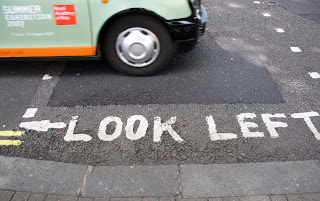
Despite getting a decent amount of rest on the flight, I was still a bit tired. We took an hour and half long nap at the flat, which only made me feel more groggy, but we we had places to go and people to see, so I pressed on. We grabbed lunch at a tiny lunch counter around the corner from the flat. I suppose that it would be wrong to visit Britain and not have at least one barely edible meal. We managed to get that one out of the way first. After finishing lunch, he headed over to
Hyde Park and
Kensington Gardens. Hyde Park and Kensington Gardens are part of a large, contiguous green space so it's hard to tell where one ends and the other begins. My favorite thing in either of the parks was the Prince Albert Memorial, which happens to fall on the Kensington Gardens side of the park. We first caught a glimpse of the top of the memorial over the tops of the trees lining the flower walk, and at first it appeared that we were looking at the spire of an ornate cathedral.
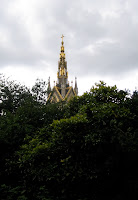
Imagine my surprise when we reached the end of the walk and discovered that it was not a cathedral, rather a massive, almost rococo memorial to the a 19th century prince. Prince Albert died of typhoid fever at the rather young age of 42 and his memorial is a testament to both the tragedy of his death and the grandeur of the British Empire, which reached its peak during the reign of his wife, Queen Victoria.
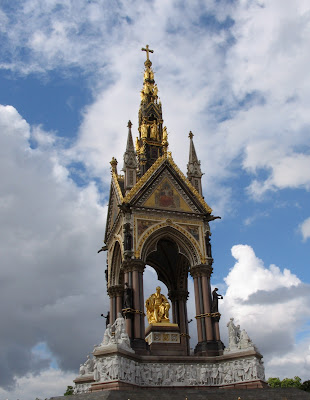
As soon as we reached the memorial, it began to rain. Fortunately, a temporary structure had been erected next to the memorial for the
Royal College of Art's summer show. We ducked into the exhibit to dodge the rain and check out the art. Most of the works on display were industrial design pieces. There was some interesting stuff there. I was fairly disappointed with the automotive design pieces, but I guess no one should be surprised that the Brits can't put together a good car anymore.
The weather soon cleared and we were back on our way. We soon came upon a memorial to another royal, this time, it was the Princess Diana Memorial. The Princess Di Memorial is as subdued as the Prince Albert Memorial is ostentatious. It's a concrete ring on a gradual slope with a stream of water running around it. Michelle was very fond of the memorial. I enjoyed its simple elegance, but I was still more impressed with the Prince Albert Memorial. I suppose that it's hard for me to appreciate a memorial to a person who died in my own lifetime, especially in a city with as much history as London.

We headed back to Alan's flat, where we met up with him and went out to dinner at an Italian restaurant near Paddington Station. The food was nothing special, but it was much better than lunch. After dinner, we headed over to Alan's local watering hole,
The Swan. It was there that I got my first taste of real cask conditioned English ale. I was really looking forward to drinking real English ale in a real English pub. My favorite beers in the States are English-style ales. I've found a few places over here that serve real cask conditioned ales and I've always enjoyed them. So it came as a surprise to me that I was initially not that impressed with real English ales. We visited a different pub each night we spent in London, and I always found the real English ales somewhat disappointing. My working theory is that while a flat and slightly warm pint of ale is a novelty in America, it's not all that exciting in England. I also think that American microbrewed ales, like American wines, have bolder flavors than their old world counterparts, and have desensitized the American drinker's palette to the subtleties of the original beverages. I have to stress that while the ale didn't meet my perhaps unrealistically high expectations, it was still beer. I can't think of a better way to spend the evening of the longest day of the year than sitting in an outdoor beer garden in the northernmost capital city of the English-speaking world with good friends and a couple of pints. Darkness finally fell around 10 pm, and we soon headed back to Alan's flat.

